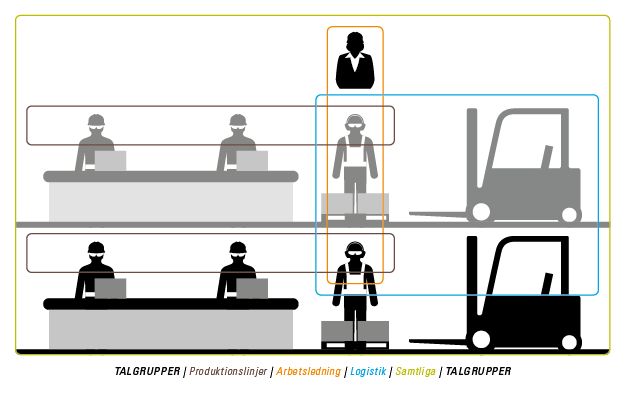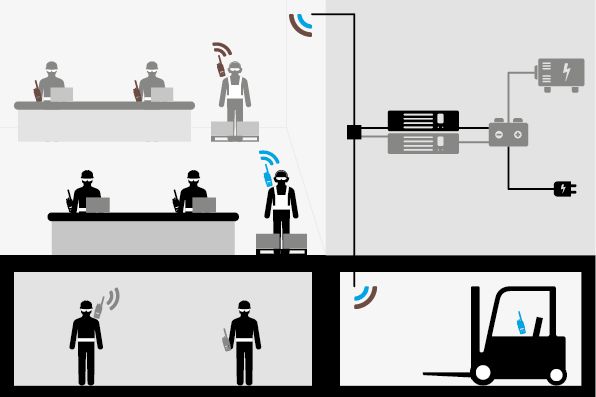In today’s smartphone focused society it is easy to think that the two-way radio is dead but if you scratch the surface you quickly realise that is a misconception. Fact is that two-way radios provide unique features compared to other technologies.
Introduction
During the last decade more and more technology has become digitised and, two-way radios are no exception. Thanks to the digital revolution radio is still the centre of many solutions for critical communications, i.e. solutions that are crucial for operational success and/or worker safety.
Your communications however do not necessarily have to be that important for the technology do make a difference. The inherent benefits can still rationalise, streamline and secure operations. Factors likely to benefit your industry and your company as well.
1. More efficient cooperation
A two-way radio call takes between zero and point five seconds to connect. After that more or less negligible times one, ten, a hundred or even several thousands of users can be addressed simultaneously, depending on how you choose to manage your communications.
Compare that to the seven seconds it takes to connect a telephone call on average, to reach one person. If more people need to be contacted the same procedure has to be repeated.
In a modern digital two-way radio system users are allocated in talk groups to direct calls. Users can belong to multiple talk groups that can be monitored simultaneously, meaning that all relevant staff can be reached with the same information at the same time.

2. More reliable coms
Two-way radio systems are almost always tailored for the organisation. That means you will get coverage where you want it, attain the capacity you need and the dependability you require. Since the system is unique for your organisation your communications are not affected by service provider issues or subscription fees for that matter.
A two-way radio can also, unlike mobile phones, communicate directly between the devices. The feature can act as a last resort in the unlikely event the system is malfunctioning or as regular means of communicating if you only have basic needs.
The devices are also developed specifically for “professional” environments, with consistently robust terminals designed and tested for a long life cycle. In general the equipment is of such high quality that it can be provided with at least five years (expanded) as well a complete service and support agreements during the entire period.
The image illustrates different levels of redundancy. In addition to the systems redundant repeaters they are also connected to a back-up battery for short term power failures as well as a generator for longer outages. Finally, the possibility to talk radio to radio is visualised, in this case in a cellar without reception.

Bilden visar de nivåer av driftsäkerhet som kan uppnås. Förutom att systemet har två ”parallellkopplade” basstationer som agerar back-up åt varandra, så är de också kopplade till ett reservdriftsbatteri för att klara kortare strömbortfall samt en dieselgenerator för längre bortfall. Slutligen visualiseras också möjligheten att tala direkt radio till radio, i detta fall i utrymme utan täckning.
3. A safer workday
In a radio system users and call types can be prioritised allowing managers and other key personnel to disburse important information even when the system is occupied. Priority also enables reliable emergency management since distress calls always have highest priority.
Almost all two-way radios are equipped with both emergency button and triggers for automatic emergency calls. This ensures users that their emergencies get through. Emergencies can also activate the microphone so that the recipients can listen in on the development.
If the devices are equipped with displays the victim can be instantly identified and if the system has location tracking enabled (out- and/or indoor), current location can be seen as well. Several two-way radios also feature an emergency search tone making it easier to physically find the person in distress, to even further safeguard users.
Emergency procedures can be adapted to reach specific people and forwarded to other systems, both internal and external. The emergencies can also be set to different levels for different purposes, such a calling for reinforcements in escalating situations, silent alarms for robberies or automatic shut-down of external equipment.
4. Tailored features
A complete chapter of its own. In addition to radios being available as both portable and vehicle mounted there are varying configurations available depending on the application. With devices ranging from water-proof models featuring voice commands for construction workers to sleek versions with display, keypad and Bluetooth for customer-facing users.
Bluetooth in particular has many practical applications. Besides enabling wireless ear-pieces the feature also allows gas sensors, bar code scanners and other peripheral equipment to be connected to the radio. In addition, Bluetooth can be used for indoor location tracking.
Contemporary two-way radio solutions are based on IP-architecture, making them easier to connect to or integrate with other digital platforms. This includes equipment like voIP-switches, or computer aided solutions like operator platforms, resources management systems or solutions for job ticketing. You can even connect a radio system to the internet to enable push-to-talk communications across any network(s). Such a solution allows, for instance, a manager to speak seamlessly with radio users on the factory floor via an app on his smartphone, no matter where he or she is.
A two-way radio can be used to remote control doors, lighting or other external equipment or, be used for collecting data or simply as a modem. Your imagination is (almost) literally what sets the limits.